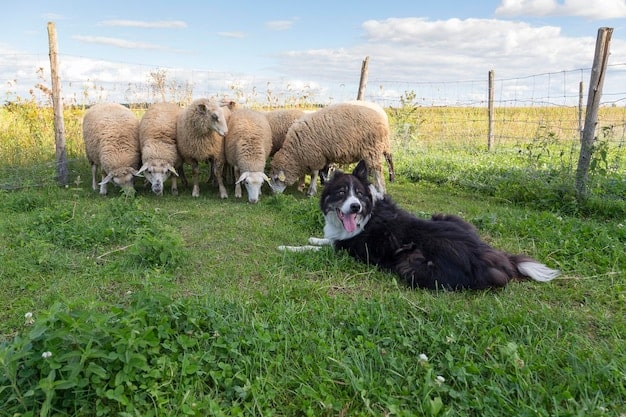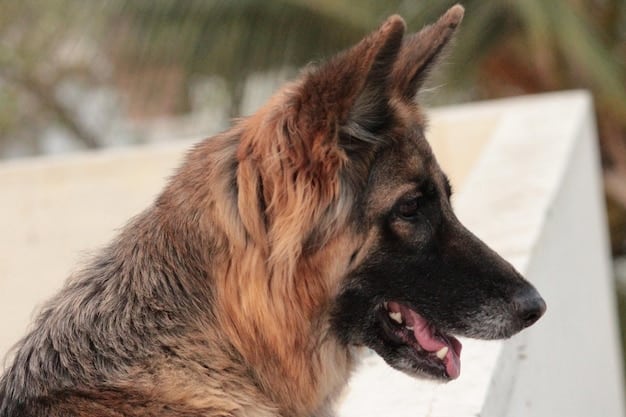Working Dog Breeds: Profiles & Training for US Owners in 2025

Working dog breeds in 2025 continue to be invaluable partners for US owners, excelling in various roles such as herding, guarding, and assistance, with tailored training approaches enhancing their capabilities and strengthening the bond between dog and owner.
Considering a working dog breed for your home or farm in the US come 2025? These intelligent and energetic dogs thrive when given a job to do. This comprehensive guide dives into the world of working dog breeds, offering breed profiles and essential training insights to help you make the best choice for your lifestyle and needs.
Understanding Working Dog Breeds
Working dog breeds are a group of canines specifically developed to perform tasks that aid humans. These aren’t your typical lap dogs. These dogs are bred for their intelligence, strength, trainability, and work ethic.
Historically, these breeds have been essential in various capacities, from protecting livestock to assisting law enforcement. Their abilities and characteristics continue to make them incredibly useful in the US even in 2025.
Historical Roles of Working Dogs
Working dogs have a fascinating history, often intertwined with the development of human civilization. Their roles have adapted and evolved over time, reflecting changing societal needs.
- Livestock Guardians: Breeds like the Great Pyrenees protected flocks from predators for centuries.
- Herding Dogs: Border Collies and Australian Shepherds expertly managed livestock movements.
- Drafting and Carting: Heavier breeds such as Bernese Mountain Dogs pulled carts and sleds, transporting goods.
- Search and Rescue: Certain breeds, like German Shepherds, have exceptional scent tracking abilities vital to search and rescue operations.
These historical functions highlight the long-standing partnership between humans and working dogs, demonstrating their critical contributions across diverse sectors.
Today, their roles continue to be valued and are being implemented differently.
Popular Working Dog Breeds in the US (2025)

The US boasts a diverse range of working dog breeds, each with unique characteristics and skills. Here are some of the most popular breeds utilized in 2025:
Understanding their individual needs is key to ensuring a harmonious relationship.
German Shepherd
The German Shepherd stands as a stalwart in various roles, celebrated for its intelligence, loyalty, and versatility. This breed excels in law enforcement, search and rescue, and as a devoted family companion.
Border Collie
Renowned as one of the most intelligent dog breeds, the Border Collie’s herding prowess is unparalleled. Their boundless energy and acute problem-solving abilities make them ideal for farms and ranches.
Great Pyrenees
Bred to guard livestock, the Great Pyrenees has a calm and gentle demeanor, making them excellent protectors. Their thick coat enables them to withstand harsh weather conditions.
Bernese Mountain Dog
Once used for drafting and farm work, the Bernese Mountain Dog is now prized for its friendly and gentle nature. They are loyal family dogs, though their large size requires careful management.
These breeds are all examples of working dogs that can make a great impression in a household.
Training Tips for Working Dog Breeds
Training a working dog breed requires a specialized approach that caters to their high intelligence and energy levels. Consistent, positive reinforcement techniques are crucial for success.
Understanding their inherent drives and channeling them constructively is vital for developing a well-behaved and engaged companion.
Early Socialization
Exposing your working dog to a variety of people, environments, and situations from a young age helps build confidence and prevents behavioral issues later on. Early socialization is critical.
Positive Reinforcement
Using rewards like treats, praise, and toys encourages desired behaviors. Consistency is key to building a strong foundation of trust and cooperation.
Mental Stimulation
Working dogs thrive on mental stimulation. Puzzle toys, training games, and challenging tasks help keep their minds sharp and prevent boredom.
- Obedience Training: Essential for establishing basic commands and control, obedience training should start early.
- Agility Training: A fun way to channel their energy and test their physical abilities, agility training is a great option for active working dogs.
- Herding Trials: If you own livestock, participating in herding trials can provide valuable outlets for their natural instincts.
Training tips are invaluable for building strong leadership within a working dog.
Health and Exercise Needs

Maintaining the health and well-being of a working dog breed requires a commitment to meeting their specific needs. Proper nutrition, regular veterinary care, and ample exercise are essential.
Understanding the breed’s predisposition to certain health conditions can help you provide proactive care and ensure a long and happy life.
Nutritional Requirements
Working dogs require a high-quality diet that supports their active lifestyle. Look for dog food formulas specifically designed for active breeds, with a balance of protein, fats, and carbohydrates.
Common Health Issues
Be aware of common health issues in your chosen breed, such as hip dysplasia, bloat, and certain genetic conditions. Regular veterinary checkups can help detect and manage these problems early.
Exercise Regimen
Working dogs need substantial daily exercise to stay physically and mentally stimulated. This can include long walks, runs, fetch, and activities that engage their natural instincts.
Without the appropriate health and exercise, these dogs struggle to be at their best.
Choosing the Right Breed for Your Lifestyle
Selecting the right working dog breed requires careful consideration of your lifestyle, living situation, and experience with dogs. It’s crucial to assess whether you can meet the breed’s specific needs.
A mismatch between your capabilities and the dog’s requirements can lead to frustration and behavioral issues.
Assessing Your Lifestyle
Consider how much time you can dedicate to training, exercise, and socialization. Working dogs thrive on interaction and activity, so a sedentary lifestyle may not be suitable.
Living Situation
Large working breeds require ample space, both indoors and outdoors. If you live in an apartment or have a small yard, a smaller, less active breed may be a better fit.
Experience with Dogs
Some working dog breeds are more challenging to train and handle than others. If you’re a first-time dog owner, consider a breed known for its trainability and gentle temperament.
- Researching Breeds: Spend time researching different working dog breeds to understand their unique characteristics, temperaments, and needs.
- Meeting Breeders: Visit reputable breeders and meet their dogs in person. This can give you valuable insights into the breed’s temperament and health.
- Considering Rescue: Consider adopting a working dog from a rescue organization. Many wonderful dogs are in need of loving homes.
Choosing the right dog is a very important decision to make.
The Future of Working Dog Breeds in the US
As we move further into 2025, the role of working dog breeds in the US continues to evolve. Technological advancements and changing societal needs are creating new opportunities for these intelligent canines.
Their adaptability ensures they remain invaluable partners across diverse sectors.
Technological Integration
Working dogs are increasingly being integrated with technology to enhance their capabilities. This includes using GPS tracking, wearable sensors, and advanced communication devices.
Expanding Roles
Beyond traditional roles, working dogs are finding new applications in areas like therapy, environmental conservation, and detecting medical conditions.
Continued Importance
Despite technological advancements, the unique abilities of working dogs – their senses, trainability, and loyalty – ensure their continued importance in the US society.
Working dogs help continue to drive innovation.
| Key Point | Brief Description |
|---|---|
| 🐕 Breed Selection | Choose a breed matching your lifestyle and capabilities. |
| 훈련 Training | Consistent, positive reinforcement is vital for effective training. |
| ⚕️ Health | Regular vet check-ups and a proper diet support their well-being. |
| 💪 Exercise | Ample daily exercise is critical for their physical and mental health. |
Frequently Asked Questions
▼
Working dog breeds are selectively bred for tasks like herding, guarding, or assisting people. They are known for their intelligence, trainability, and strength.
▼
Begin with early socialization and positive reinforcement techniques. Consistency is vital. Gradually introduce mental and physical challenges as part of their daily routine.
▼
It depends on the breed’s energy level and size. Smaller working breeds with moderate exercise needs can adapt, but regular outdoor activities are essential to prevent restlessness.
▼
Common issues include hip dysplasia, bloat, and certain genetic conditions. Regular veterinary checkups can help detect and manage these problems early for longer comfort.
▼
Working dogs typically require at least one to two hours of exercise daily. This should include activities that engage both their bodies and minds, like games or training sessions.
Conclusion
Understanding the unique traits and training needs of working dog breeds is helpful for any US owner in 2025. These dogs provide companionship and serve vital roles in various sectors. By providing the proper care, these breeds will continue to be loyal workers and friends.





